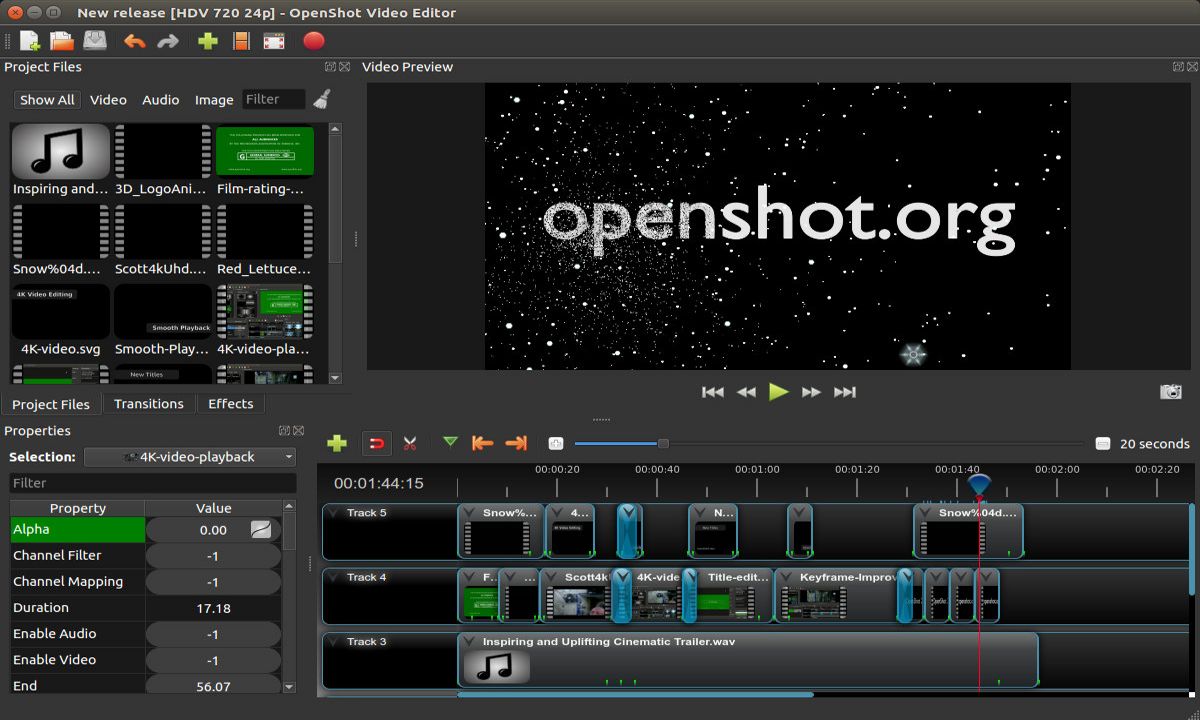
After a year and a half of development the release of the new version of the non-linear video editor OpenShot 2.6.0.
For those who are unfamiliar with OpenShot, you should know that this is a popular free open source video editor written in Python, GTK and the MLT framework, created with the goal of being easy to use. The publisher is available on different operating systems as are Linux, Windows and Mac. It also has support for high resolution videos and various video formats, audio and still image.
This software It will allow us to edit our videos, photos and music files and be able to edit them at will for creating videos and with a simple interface that allows us to easily load subtitles, transitions and effects, to later export them to DVD, YouTube, Vimeo, Xbox 360 and many other common formats.
Main new features of OpenShot 2.6.0
In this new version of the video editor, one of the main novelties that stands out is the Chrome OS platform support, in addition to that it has also included the support for the packages FFmpeg 4 and WebEngine + WebKit and Blender compatibility has been updated.
In OpenShot 2.6.0 we can see that work has been done to increase productivity. Some operations have been moved to a single threaded execution scheme, which made it possible to achieve higher performance and bring the speed of operations closer to calling FFmpeg without interlayers.
Transitioned to using the RGBA8888_Premultiplied color format in internal calculations, where transparency parameters are calculated in advance, reducing CPU load and increasing rendering speed.
In addition, a completely redesigned transformation tool has been introduced, which allows you to perform operations such as resize, rotate, crop, move, and scale. The tool automatically triggers when you select any clip, it fully supports the keyframe animation system and can be used to create animations quickly. To simplify the tracking of the position of the area during rotation, the support for the anchor point (cross in the middle) is implemented. When scaling with the mouse wheel during preview, the ability to see objects outside the visible area has been added.
As well tuning operations have been improved, including support for snapping while trimming the edges of a clip to make it easy to align trims that span multiple tracks. Added support for snapping to current playhead position.
Added a new caption effect to draw captioned text over video, With it, you can customize the font, color, borders, background, position, size, and fill, as well as apply simple animation to make text appear and disappear.
Added a new zoom slider widget that simplifies timeline navigation by dynamically previewing all content and displaying an abbreviated view of each clip, transform, and track. The widget also allows you to highlight the part of the timeline of interest for a more detailed view by defining the field of view using blue circles and moving the formed window along the timeline.
We can also find that in this new version includes new effects based on the use of computer vision and machine learning technologiesas well as a stabilization effect eliminates distortion resulting from camera shake and shake.
The tracking effect allows you to mark an element in a video and track its coordinates and additional movement in frames, which can be used to animate or attach another clip to the coordinates of an object.
As well as an object detection effect that allows you to classify all objects in the scene and highlight certain types of objects, for example, mark all cars in the frame.
And as for the new sound effects have been added:
- Compressor: increases the volume of low sounds and decreases loud sounds.
- Expander: Makes loud sounds louder and quiet sounds quieter.
- Distortion: changes the sound by cutting off the signal.
- Delay: add delays to sync audio and video.
- Echo: delayed sound reflection effect.
- Noise - Adds random noise at different frequencies.
- Parametric EQ: allows you to change the volume with reference to frequencies.
- Robotization: distort the voice, making it look like a robot voice.
- Whisperization: turns the voice into a whisper.
How to install OpenShot 2.6.0 on Ubuntu and derivatives?
This new update is not in the official Ubuntu repositories, so you need to add your official repository, for this you will have to open a terminal and add the official repositories.
sudo add-apt-repository ppa:openshot.developers/ppa
We update the repositories
sudo apt-get update
And finally we install the video editor on our system.
sudo apt-get install openshot-qt
As well it is possible to download the application in an appimage format, for this we must download the following file from the terminal:
wget https://github.com/OpenShot/openshot-qt/releases/download/v2.6.0/OpenShot-v2.6.0-x86_64.AppImage
We give you execution permissions with
sudo chmod a+x OpenShot-v2.6.0-x86_64.AppImage
And we execute with:
./OpenShot-v2.6.0-x86_64.AppImage
Or in the same way, they can run the application by double clicking on the downloaded file.